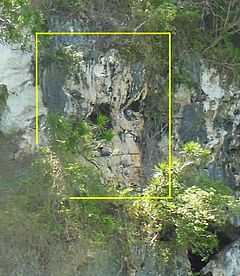Tabon Caves
| Tabon Caves | |
|---|---|
| Mga Kweba ng Tabon | |
|
Apparent skull carved in rock above main entrance | |
.svg.png) Location of Tabon Cave in the Philippines | |
| Alternate name | Tabon Cave Complex |
| Location | Quezon, Palawan, Philippines |
| Coordinates | 9°16′48″N 117°58′53″E / 9.279882°N 117.9814°ECoordinates: 9°16′48″N 117°58′53″E / 9.279882°N 117.9814°E |
| Type | Cave |
| Management | National Museum of the Philippines |
The Tabon Caves, dubbed as the Philippines' Cradle of Civilization,[1] are a set of caves located on Lipuun Point, north of Quezon municipality, in the south western part of the province of Palawan on Palawan Island, in the Philippines. The caves are named after the Tabon Scrubfowl. It is bordered on the south by the town proper of Quezon, Bgy. Panitian on the west, and the South China Sea on the north and east. Out of the total 215 caves known to exist on Lipuun Point, the Tabon Caves complex has 29 explored caves where only seven of which are open for public viewing. The major caves open to the public are Tabon Cave, Diwata Cave, Igang Cave, and Liyang Cave. The Tabon Man was discovered in the caves, one of the oldest remnants of human inhabitants found in the Philippines.[2] Other remains that were excavated have remained onsite and have yet to be examined in detail.
The caves complex are maintained and managed by the National Museum[3] and is declared by a National Cultural Treasure by the same institution in February 2011.[1][2][4]
Archaeological discoveries
The caves were discovered by Dr. Robert B. Fox and his team from the National Museum of the Philippines in 1962. The greatest find of the team is a skull cap remains of the Tabon Man found in the cave which is believed to be approximately 22,000-24,000 years old.[2][3] The team also found burial jars, like the Manunggul Jar (another National Cultural Treasure) earthenware, jade ornaments and other jewelry, stone tools, animal bones, and human fossils dating back to 47,000 years ago, earliest human remains found in the Philippines.[5] The archaeological finds indicate habitation from 50,000 to 700 years ago while the limestone formation in the reservation dates back from 25 million years ago, or the Lower Middle Miocene Period, based on geological studies.
The Lipuun Point Reservation, covering a 138-hectare island connected to the Palawan mainland by a mangrove forest, was declared a Site Museum Reservation in April 1972 and was made a priority site for tourism development in 1991 for its natural and cultural heritage.
In recent years, verification of facts in addition to further analysis of previously collected samples has allowed for a greater understanding of the site as a whole. Radioisotope dating techniques have been able to show a period of near continuous habitation from 30,000-9,000 years ago. Human remains as well as rock flakes, hammers, and other stone tools indicate the cave may have been used as a workshop.[6] The bone fragments found in the caves have been suggested to have been from the late Pleistocene to early Holocene periods.[6] Previous excavations of the site have also revealed evidence of a diet including pig and deer, which is extinct in the Philippines today. While little new data is available because of the cave's location and safety concerns, they are slowly being excavated and the old data is being reexamined.
Igang Cave Findings

Igang is one of the upper caves and one of the longest of the complex. It appears to have been the primary burial site and most of the burial jars were found here. Until 2013 no one gave any particular notice to the large brown and green forms that ring the inner entrance to the cave. However, an American tourist named Philip Maise, after closely reviewing cave photographs realized that he may be looking at large sculptures of Asian elephants. Asian elephants are still present on the neighboring island of Borneo.The sculptures themselves appear to have been made from an ancient form of cement. During the last ice age, they could have walked to Palawan.
Gallery
-
Docking station and entrance to the complex
-
One of the chambers of the Tabon Cave Complex Site
-
Rehabilitation works on Tabon Cave
-
View of the site in Lipuun Point, Quezon, Palawan
References
- ↑ 1.0 1.1 Mendoza, Victoria Asuncion (August 7, 2012). "Tabon Cave in Palawan declared Nat'l Cultural Treasure". Philippine Information Agency. Retrieved September 2, 2014.
- ↑ 2.0 2.1 2.2 "Philippine Caves Declared National Cultural Treasure". Caving News. August 8, 2012. Retrieved September 4, 2014.
- ↑ 3.0 3.1 "Tabon Caves: Site of an important Philippine archaeological discovery". Palawan Council for Sustainable Development. Retrieved 1 February 2009.
- ↑ "Tabon Cave in Palawan: A national treasure". August 15, 2014. Retrieved September 4, 2014.
- ↑ "The Tabon Cave Complex and all of Lipuun". UNESCO World Heritage Centre. 16 May 2006. Retrieved 1 February 2009.
- ↑ 6.0 6.1 "Notes on the Morphology and Age of the Tabon Cave Fossil Homo sapiens". The University of Chicago Press. October 2014. Retrieved 1 November 2014.
External links
| Wikimedia Commons has media related to Tabon Caves. |
- Tabon Cave Story Video of caves.
- National Museum of the Philippines Anthropology Section.
- Arts of the Philippines Article on the Manunggul Jar
| |||||||||||||||||||||||||||||||||||||||||||||||||||||||||||||||||||||





